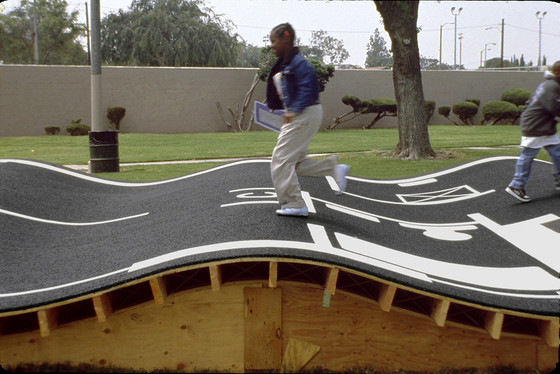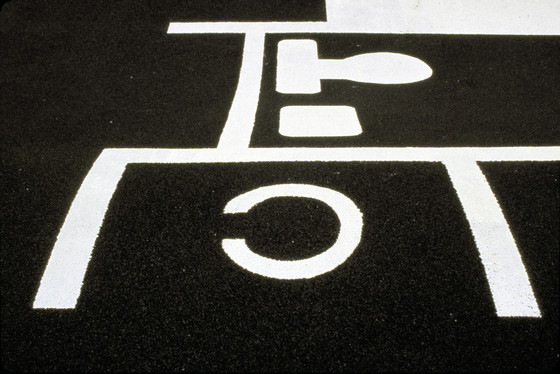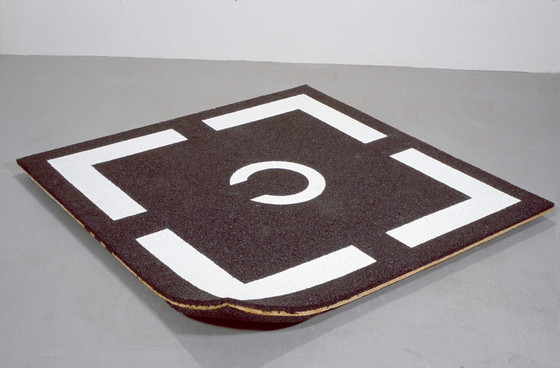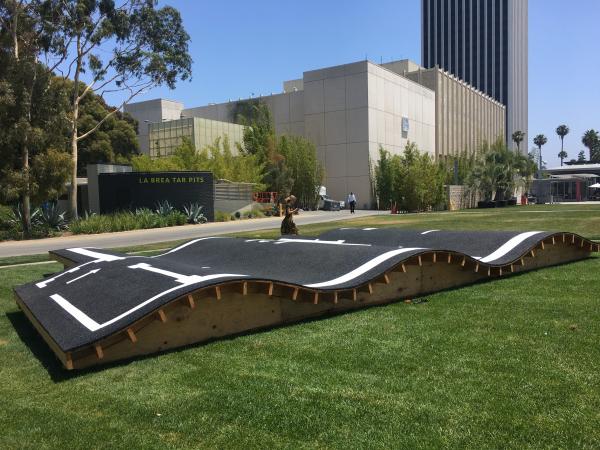Entering LACMA from 6th Street near Ogden Drive, one will encounter an open, outdoor sculpture that replicates to scale the floor plan from an apartment in Los Angeles's Nickerson Gardens, a 156-building complex with 1,110 units that is the largest public housing development west of the Mississippi. The sculpture is covered with soft rubber playground-safety surfacing and the rooms are outlined in white paint. The level floor is transformed into an undulating wave, evoking both Aladdin’s rug and the waves of the Caribbean Sea. The viewer is invited to play on its surface.

This work is by artist María Elena González (Cuba, b. 1957; active in the United States). Titled Magic Carpet/Home (2003/2017), it recreates the original 2003 installation based on an apartment in Watts. In 2003, the work was located near the apartment building in Ted Watkins Park, where local residents could interact with and play on the sculpture over a six-month period. In 1999, González did earlier iterations of Magic Carpet/Home using public housing and parks in Brooklyn and Pittsburgh. Over the next year, the artist began works of “imaginary architecture,” including a Mnemonic Architecture series of drawings of her childhood home in Cuba based on memory. These drawings were exhibited at the Ludwig Foundation of Cuba in Havana in 2000 when she visited the island for the first time since leaving 32 years earlier. Once in Cuba, González had a chance to see the distorted proportions of the “memory that was imprinted on my mind when I left Cuba.”

So by the time González created the Los Angeles version of Magic Carpet/Home in 2003, the series clearly imbricated the artist’s strong Minimalist concerns with “density, objects in space, format, composition, and color” with her social and even personal concerns that necessarily “embody content” in order to be more accessible to a larger public. In Magic Carpet/Home, only the closet is labeled, the letter “C” placed within the space, while the play that takes place on the undulating surface inevitably ignores the boundaries that shape and govern a home. The closet was the focus of a related gallery-based work, C-Carpet (2001). This work’s minimalist gestures—the letter “C” and an upturned corner of the carpet—bring a metaphorical pressure to the “hidden socialized space” of the closet and the idea of sweeping things under the carpet.

Nickerson Gardens is one of four housing projects built by the Housing Authority of the City of Los Angeles (HACLA) during World War II in Watts, a high-density two-square mile neighborhood in South Los Angeles. It is during this period, as part of the Great Migration from the South, that Watts became predominantly African American, with families confronting racial violence, overcrowding, high rents, and limited access to basic services (health care, schools, and transportation). González's Magic Carpet/Home was part of a public art program by Los Angeles Contemporary Exhibitions—on in which the artists engaged city agencies and consulted community organizations and residents in an art-based effort to redefine public space in relation to home, and vice versa. González is not equating the Cuban exile with the Great Migration, nor is she equating sexual repression with racialized poverty, but she is bringing them into the home.
What is central to Magic Carpet/Home is that these issues about home are transformed into the idiom of play, and that the idea of home is opened up rather than enclosed, becoming indistinguishable from the outside against which home is usually defined. The work is at once a diagrammatic representation of an actual residence in the neighborhood in which the work was first installed and an outdoor invitation to play as if on a “magic carpet” that can take you somewhere else.
But where?
Into the galleries! In recreating the work on the LACMA campus grounds, the artist extends the original dialogue and interactions around home from the original community in Watts to a public museum. The work thus also serves as an introduction and guidepost to the rest of the Home—So Different, So Appealing exhibition located on BCAM, Level 3. Viewers are encouraged to consider González’s version of home in relation to Home installations that present closed or inaccessible spaces: Pepón Osorio (Puerto Rico, b. 1955, active in United States), Badge of Honor (1995), and Daniel J. Martinez (United States, b. 1957), The House that America Built (2004/2017). But also those that are immersive: Abraham Cruzvillegas (Mexico, b. 1978), Autoconstrucción (2013) and Luis Camnitzer (Germany, b. 1937, active in Uruguay and United States), Living Room (1968). Each offers a distinct vision of home that also takes you somewhere else.
Home—So Different, So Appealing: Art from the Americas since 1957 opens on June 11, 2017. The exhibition is part of Pacific Standard Time: LA/LA, a far reaching and ambitious exploration of Latin America and Latino art in dialogue with Los Angeles. Member previews are June 8–10, 2017.



